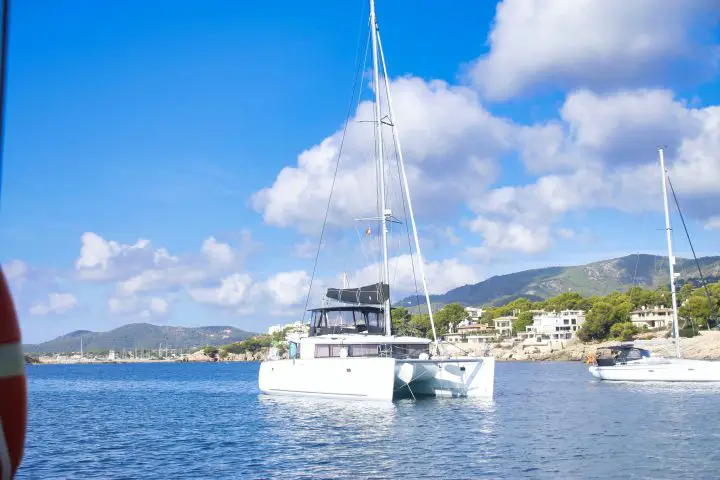Most sailboats have one because they’re awfully handy. But sailboat booms are also one of the most dangerous parts of the boat, and they demand our understanding and respect.
Here’s a look at sailboat booms, some of their basic parts and terminology, as well as some no-brainer tactics and equipment to make cruising a little safer. If your sailing lingo is a little rusty, you can brush up on your sailing terms and parts of a sailboat before diving in.
Table of Contents
- What is a Sail Boat Boom?
- Parts of a Boom on Sailboat
- Avoiding Trouble – The Importance of Preventers and Brakes, And the Difference Between the Two
- Don’t Let Your Sailboat Boom Go Boom!
- Boom on a Sailboat FAQ

What is a Sail Boat Boom?
A sailboat boom is a horizontal spar that holds the foot of a sail. They’re most common on the mainsail, although they are also sometimes used on staysails. On a two-masted sailboat, called a ketch, the mizzensail will have a boom. The boom provides support and helps shape the sail.
As with the mast, usually the sail attaches to the boom with slides. Most booms are made of aluminum, but wood is traditional, and carbon fiber composites are the state-of-the-art option in the cruising world.
Another advantage of the boom is that it allows you to attach more control lines. By connecting several different lines in different areas, sailors can shape the sail to meet the conditions better than a sail with no boom, which can only be controlled with a single line.
It’s rare to see a fore and aft rigged sailboat without at least one boom. There are a few rare rig types, however, that don’t use them, like the lateen. If a sail is not connected to a boom or is only connected at the clew end, it is said to be “loose-footed.”
Booms also offer options for sail storage. For example, many sailboats store their mainsails in bags built on top of the boom. Some advanced systems include lines that flake the sail into the bag for easy deployment and retrieval.
Problems with the Boom on a Sailboat Sailing Downwind
The boom is one of the most dangerous parts of a sailboat. The boom will swing across the boat when the boat tacks or jibes. If crew members or passengers are caught unaware, the boom will smash right into their heads and knock them overboard.
Tacks on upwind points of sail are safer than downwind jibes because the boom is sheeted in and held close to the boat’s centerline when tacking a sailboat. In other words, the boom doesn’t move very far during a tack.
During a jibe, on the other hand, it moves from one side of the boat to the other. If the jib is accidental or otherwise uncontrolled, the force of the boom slamming across is more than enough to injure someone or damage the boat. Accidental jibes are bad news, and a potential raging boom is deadly.

Parts of a Boom on Sailboat
Here’s a look at the components you might encounter on a typical cruising boat’s boom.
Sheet
The main control line for any sail is called the sheet. You bring a fore and aft sail closer to the boat’s centerline when you sheet the sail. This is for sailing upwind.
When you ease out a sheet, you let the sail relax and come perpendicular (or nearly so) to the boat’s centerline. This is the case when sailing downwind.
Since mainsails are usually larger and heavier than headsails, the sheet needs more power. Therefore, main sheet systems are rigged with some amount of purchase in the system to make it mechanically easier to sheet in a loaded sail.
The sheet is usually attached to a block and tackle system that moves from side to side on the deck. This is called the traveler. The traveler can be used to fine-tune the sail trim.
Gooseneck Fitting
The boom attaches to the mast at the gooseneck fitting. This special attachment allows the boom to swing side to side and angle up and down. This freedom of movement is vital to trim the sail in any wind condition.
The gooseneck is usually a fairly expensive part and one of the easier things to break. It’s subject to the tremendous force of the mainsail and wears with every little movement.
Topping Lift
The topping lift is simply a line that holds the end of the boom off of the boat when the sail isn’t up. When the sail is flying, the boom is more or less attached and held up by the sail.
But nothing remains to hold up the boom when the sail is dropped. That’s why the topping lift is so important. If it weren’t there, the whole boom would crash down onto the boat when you released the halyard to lower the sail. Yikes!
Boom Vang
The vang is a control line that runs from the base of the mast and up to the boom at an angle. It may look like a second sheet, but it doesn’t control where the boom goes.
Instead, the vang applies pressure and a downward force on the forward section of the boom. It pulls it, resisting the sail that tries to pull it up. Doing so keeps the sail flatter, which is better for strong wind conditions.
Larger boats now come with solid boom vangs. These use a hydraulic system to hold the boom in place. Today topping lifts are used as a backup to these hefty “kickers” on some boats.
Reefing Systems
Reefing is the action of reducing sail when the wind pipes up.
Booms allow the use of a few different types of reefing systems. The most common is the jiffy or slab reefing system.
With this system, the sailor releases the halyard to lower the sail slightly. A reefing tack is secured to the boom near the gooseneck. A permanent reefing line is run from the reefing clew, at the back of the sail, through a block at the aft end of the boom and then forward to the base of the mast.
Pulling this reefing line tight, the sailor can secure the sail’s tack and clew at the mast. In some cases, one or two reef lines can be run together and then led back to the cockpit, allowing a sailor to shorten sail from the helm.
Sail Management System
The boom provides a structure where the sail can be stored when not in use. The most simple example is the sail bag. The sail is lowered, folded nicely (flaked), then sail ties are used to lash it to the boom. Then, a custom-fitted bag holds the sail to the boom and protects them both.
Lazy Jacks and Stack Packs
To help keep the sail on top of the boom when raising or lowering it, small lines can be added. They run from a point high on the mast down to multiple points along the boom.
When the sail is dropped, the lines keep the sail from spilling down onto the deck.
An upgraded version of this is the stack pack. A stack pack combines the lazy jacks and the sail bag into one product. Lazy jack lines keep the sail from spilling onto the deck, and the bag is built into the lines around the boom. There’s a zipper on the top, so to tidy away the sail, all one has to do is drop the sail into the bag and pull the zipper closed.

Dutchman
The Dutchman flaking system is another sail management product like the Lazy Jack. The Dutchman uses vertical lines running from the boom to the topping lift. The sail has a line of grommets that go around these lines, so as the sail comes down, it flakes naturally around the Dutchman line.
In-Mast Furling
Many boats are equipped with in-mast furling systems. These allow the sail to be rolled up inside the mast when not in use.
The boom on a boat with in-mast furling works like any other, but the outhaul line becomes more important. The outhaul is run from the sail’s clew and then back to the rear end of the boom. It then goes to the mast, where it can be led aft to the cockpit.
Pulling the outhaul is what unrolls the sail. An inhaul line, or furling line, rolls up as the sail comes out. Pulling that line again while easing the outhaul will roll the sail back up inside the mast.
With in-mast furling, there’s no need for reefing lines, sail bags, lazy jacks, stack packs, or any other sail management. Instead, it’s as simple as a furling jib.
Furling Booms
In-mast furling has a lot of problems, however. The sail must be loose-footed to work, and it cannot have horizontal battens. That means that the sail must be smaller than it would otherwise need to be.
In-boom furling solves this by furling the sail around the boom. This system allows for full-batten sails with a larger, fuller roach. These powerful sails are common on modern cruising boats, especially catamarans.
The furling boom also has a fail-safe design. An in-mast furling system can get fouled, leaving the sailor with the sail up and a big problem if the wind is high. With the furling boom system, you can always drop the sail in the case of a malfunction or jam.
What is a Boom Gallows? Help with a Heavy Sail Laden Boom
Many older bluewater boats have boom gallows. It’s a wooden arch that spans the cockpit of the boat. It has notches in it where the boom can sit.
The purpose of a boom gallows is to provide a hard point where the boom can be sat. Should the topping lift fail or get accidentally released, the boom will come crashing to the deck and could cause damage. The boom gallows provides a place for it to land without anything or anyone getting hurt.
Of course, the boom gallows is handier than that. The ability to set the boom down and secure it makes operations in rough seas much safer. This is especially true in older designs where sailors had to go up to the mast to reef the sail. This will keep the crew much safer rather than dealing with a madly swaying, dangerous flailing boom that will cause problems in rough sea conditions.
It even makes things better at the dock or anchor. The gallows allows you to release the tight topping lift when not in use and secure the heavily-laden sail boom. This reduces stress on the boat’s rig because things won’t be swinging around with every wind gust and wave.
The boom gallows is mounted in a strong attachment place and makes an excellent handhold to boot.
Wishbone Booms
An alternative to the standard boom is the wishbone. These are typically found on windsurfing boards, but a few boat designs have also incorporated them.
One example is the Nonsuch, a catboat-like cruising boat with distinctive wishbone booms.

Avoiding Trouble – The Importance of Preventers and Brakes, And the Difference Between the Two
The boom is one of the most dangerous parts of a sailboat. Small boats, in particular, seldom have the booms mounted high enough for someone to stand under.
When the boat comes through the eye of the wind, as when tacking upwind or jibing downwind, the boom will cross from one side of the boat to the other.
If the skipper is on their game, they’re going to approach both of these situations carefully. They’re not going to let the boat do it without letting everyone on board know what will happen. And they’re not going to do it until everyone is out of the way.
Boats do, of course, accidentally jibe sometimes. When the boom swings around, the chances it could knock someone overboard are extremely high. In strong winds, the boom can easily knock someone unconscious at the same time.
It can also damage the boat. The gooseneck isn’t designed to absorb the loads of a powerful jibe. Jibes need to be controlled, or else it’s pretty easy to break things.
Boom Preventer
A preventer is a line tied to the boom to ensure it stays on one side of the boat. On cruising boats, preventers are rigged so that if an accidental jibe happens, it won’t hurt anyone or damage anything.
Preventers are usually rigged from the boom forward to a midship or bow cleat. To jibe intentionally, you must release the preventer first. Once the jibe is complete, it can be resecured on the other side of the boat.
Boom Brakes
A brake is not a preventer and will not stop an accidental jibe. Instead, it works just like it sounds like it would–it slows the boom down.
A brake is a special fitting mounted to the bottom of the boom. A line is run from each side of the boat and through the fitting. As the boom moves, the line travels through the brake fitting, but not easily. The whole point of the brake is that it adds friction and slows the boom down.
You don’t have to release a boom brake to jibe, but you might have to adjust it a little. This is because the amount of friction it puts on the line is a factor of how it is rigged.
The boom brake reduces stress and loads on the rig during jibes. It also provides a little more reaction time for the crew so that a crash jibe doesn’t happen as fast as it otherwise would.
A boom brake could be used in conjunction with a preventer to be completely effective.
This video shows how to use various brakes and preventers.
Don’t Let Your Sailboat Boom Go Boom!
The boom demands respect from all sailors and sailboat passengers. It’s too easy to get hurt, and no helmsperson is completely infallible. Nevertheless, accidents happen, and it makes far more sense to prepare for them with simple rigging and equipment before the fact.
Boom on a Sailboat FAQ
Can you raise the boom on a sailboat?
It depends a lot on the design of the boat. At the very least, you may have to adjust the sail measurements to suit you since you are effectively reducing your mast height by raising the boom. When in doubt, it’s best to consult with an experienced rigger.
What holds the boom down on a sailboat?
When the sail is flying, the boom is held down by gravity. The sheet is the line that will pull the boom closer to the boat and control its position. The sail holds the boom up.
When the sail is down, the boom is held up by a line called the topping lift. The tight mainsheet opposing it keeps it from swinging freely.

